
Oil painting is a painting method involving the procedure of painting with pigments with a medium of drying oil as the binder. It has been the most common technique for artistic painting on canvas, wood panel or copper for several centuries, spreading from Europe to the rest of the world. The advantages of oil for painting images include "greater flexibility, richer and denser colour, the use of layers, and a wider range from light to dark". But the process is slower, especially when one layer of paint needs to be allowed to dry before another is applied.

Canvas is an extremely durable plain-woven fabric used for making sails, tents, marquees, backpacks, shelters, as a support for oil painting and for other items for which sturdiness is required, as well as in such fashion objects as handbags, electronic device cases, and shoes. It is popularly used by artists as a painting surface, typically stretched across a wooden frame.
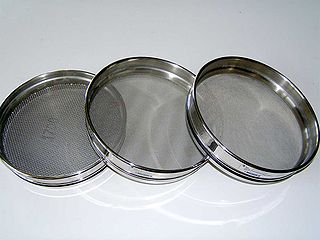
A sieve, fine mesh strainer, or sift, is a tool used for separating wanted elements from unwanted material or for controlling the particle size distribution of a sample, using a screen such as a woven mesh or net or perforated sheet material. The word sift derives from sieve.

A stretcher, gurney, litter, or pram is an apparatus used for moving patients who require medical care. A basic type must be carried by two or more people. A wheeled stretcher is often equipped with variable height frames, wheels, tracks, or skids.

Upholstery is the work of providing furniture, especially seats, with padding, springs, webbing, and fabric or leather covers. The word also refers to the materials used to upholster something.
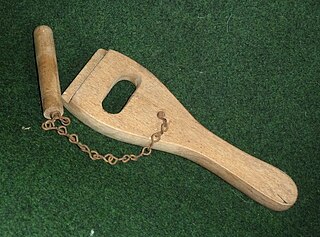
A webbing stretcher is an upholstery tool used to stretch webbing.

A washstand or basin stand is a piece of furniture consisting of a small table or cabinet, usually supported on three or four legs, and most commonly made of mahogany, walnut, or rosewood, and made for holding a wash basin and water pitcher. The smaller varieties were used for rose-water ablutions, or for hair-powdering. The larger ones, which possessed receptacles for soap dishes, were the predecessors of the modern bathroom wash basin, or sink. Both varieties, often of very elegant form, were in extensive use throughout a large part of the 18th century and early-19th century, eventually disappearing with the advent of modern indoor plumbing.
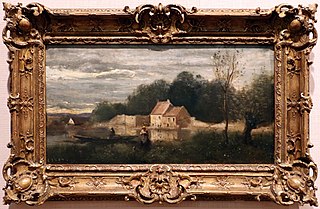
A picture frame is a protective and decorative edging for a picture, such as a painting or photograph. It makes displaying the work safer and easier and both sets the picture apart from its surroundings and aesthetically integrates it with them.
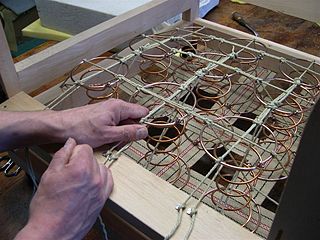
In furniture-making, the upholstery frame of a piece of furniture gives the structural support and determines the basic shape of the upholstered furniture. The frame may be a basic piece of wooden furniture before it is upholstered. Like a finished piece of furniture before the upholstering, the frame establishes the final quality, including its durability, and limits the final design, padding, cushioning, or cover.

An awning or overhang is a secondary covering attached to the exterior wall of a building. It is typically composed of canvas woven of acrylic, cotton or polyester yarn, or vinyl laminated to polyester fabric that is stretched tightly over a light structure of aluminium, iron or steel, possibly wood or transparent material. The configuration of this structure is something of a truss, space frame or planar frame. Awnings are also often constructed of aluminium understructure with aluminium sheeting. These aluminium awnings are often used when a fabric awning is not a practical application where snow load as well as wind loads may be a factor.

A butt joint is a wood joint in which the end of a piece of material is simply placed against another piece. The butt joint is the simplest joint. An unreinforced butt joint is also the weakest joint, as it provides a limited surface area for gluing and lacks any mechanical interlocking to resist external forces.

A stretcher bar is used to construct a wooden stretcher used by artists to mount their canvases.

Gallery wrap is a method of stretching an artist's canvas so that the canvas wraps around the sides of the stretcher bar or strainer bars and is secured to the back of the wooden frame.

A bed frame or bedstead is the part of a bed used to position the bed base, the flat part which in turn directly supports the mattress(es). The frame may also stop the mattress from sliding sideways, and it may include means of supporting a canopy above. There are several types of Bed Frames found around the globe. They are typically made of wood or metal. A bed frame includes head, foot, and side rails. The majority of double (full) beds and all queen- and king-sized beds necessitate a central support rail, often accompanied by additional feet that extend towards the floor for stability. The concept of a "bed frame" was initially introduced and referred to between 1805 and 1815. This foundational support system not only reinforces the structure of the bed but also ensures its durability and longevity, distributing weight evenly to prevent sagging and enhance overall comfort. Not all beds include frames: see bed base.

A canvas print is the result of an image printed onto canvas which is often stretched, or gallery-wrapped, onto a frame and displayed. Canvas prints are used as the final output in an art piece, or as a way to reproduce other forms of art.

Embroidery hoops and frames are tools used to keep fabric taut while working embroidery or other forms of needlework.
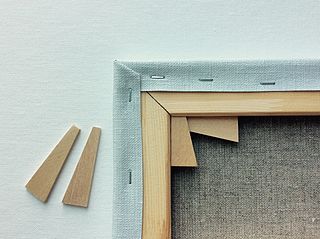
A tightening key is a small wedge or shim used in the construction of a canvas stretcher frame with expandable joints. The key is inserted into the slotted inside the stretcher bars at the mitered corners of the frame to prevent or adjust sagging. Tightening keys are commonly made in plastic or wood, and are often called corner keys or corner wedges. Tightening keys were introduced in the mid-18th century, making expandable stretcher frames possible.

The Allis-Chalmers M7 snow tractor was designed for use by the U.S. Army Air Corps as a rescue vehicle in remote northern bases.
A stretcher is a medical device used to carry a person from one place to another.

The conservation and restoration of paintings is carried out by professional painting conservators. Paintings cover a wide range of various mediums, materials, and their supports. Painting types include fine art to decorative and functional objects spanning from acrylics, frescoes, and oil paint on various surfaces, egg tempera on panels and canvas, lacquer painting, water color and more. Knowing the materials of any given painting and its support allows for the proper restoration and conservation practices. All components of a painting will react to its environment differently, and impact the artwork as a whole. These material components along with collections care will determine the longevity of a painting. The first steps to conservation and restoration is preventive conservation followed by active restoration with the artist's intent in mind.



















